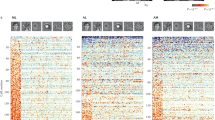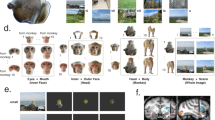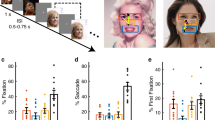Abstract
Although monkeys can perceive complex stimuli such as faces1, only the higher apes are capable of recognizing their own face in a mirror2. Here we show that in humans the right hemisphere of the brain seems to be preferentially involved in self-face recognition. Our findings indicate that neural substrates of the right hemisphere may selectively participate in processes linked to self-awareness.
Similar content being viewed by others
Main
We first studied a group of patients undergoing the intracarotid amobarbital (Wada) test. The Wada test involves anaesthetization (that is, inactivation) of one cerebral hemisphere in order to provide information regarding cerebral dominance for language and other cognitive phenomena. Five right-handed (left hemisphere is language-dominant) patients, who were undergoing Wada tests for evaluation for surgery to treat epilepsy, were shown pictures of faces generated by morphing the picture of a famous person with the patient's own face (Fig. 1). Patients were instructed to remember the picture presented. Different pictures were presented during selective anaesthesia of the right and the left hemispheres.
Following anaesthesia of the left hemisphere (LH), patients selected the 'self' face as having been shown to them (5/5); after anaesthesia of the right hemisphere (RH), patients selected the famous face as the one they had viewed (4/5). In a second experiment with 10 normal subjects (results not shown), transcranial magnetic stimulation was delivered to the motor cortex of the RH or LH during self–famous or familiar–famous morph display. The amplitude of the resulting motor-evoked potentials (MEPs) was significantly greater for the RH than for the LH during presentation of self morphs (M = 1.26 mV and M = 1.02 mV; s.e., 0.09, respectively) and the former (RH, self morph) was also significantly greater than the MEP amplitude from both hemispheres during presentation of familiar morphs (RH, familiar: M = 1.04 mV, s.e., 0.07; LH, familiar: M = 1.03 mV, s.e., 0.08).
After recovery from anaesthesia, patients were given a forced-choice task in which they had to choose the picture of the face that they had been shown. The two choices were the pictures from which the morphed image had been generated (self and famous), although neither choice had actually been presented during anaesthesia. Following anaesthesia of the left hemisphere, all five patients selected the 'self' face as the one they thought had been presented; however, after anaesthesia of the right hemisphere, four out of the five selected the famous face. These results suggest that the anterior right hemisphere may be critically engaged in detecting the self face.
To find out whether a similar effect operates in normal subjects, we presented morphed photographs to ten volunteers (instructed to attend to the photographs) and delivered transcranial magnetic stimulation to the motor cortex of the left or right hemisphere at random times (100–450 ms) during picture presentation. We measured the amplitude of the motor-evoked potentials induced by this stimulation in the contralateral first dorsal interosseous muscle as an indicator of the amount of activation of each hemisphere3 during exposure to pictures morphing their own or a familiar face with that of a famous person.
We found that there was a significant association (P < 0.05) between subjects' hemisphere activation and their exposure to the 'self'and 'familiar' conditions. Post-hoc Bonferroni tests revealed that motor-evoked potentials were significantly greater from the right hemisphere while subjects viewed pictures containing elements of their own face than for all other conditions.
Some people can suffer from neglect or misidentification of their own extremities (a condition known as asomatopagnosia) after damage4 to or anaesthetization5 of the right hemisphere. It is also known that patients with lesions to the right fronto-temporal cortex may experience a cognitive detachment from self6. This recently evolved network includes prefrontal regions of the brain and demonstrates a high degree of lateralization7 in humans and apes, but not in monkeys. It is conceivable that a right-hemisphere network gives rise to self-awareness, which may be a hallmark of higher-order consciousness8.
References
Pineda, J. A., Sebestyen, G. & Nava, C. Brain Res. Cogn. Brain Res. 2, 1–12 (1994).
Gallup, G. G. Science 167, 86–87 (1970).
Tormos, J. M. et al. Neurology 49, 487–491 (1997).
Feinberg, T., Haber, L. & Leeds, N. Neurology 40, 1391–1394 (1990).
Meador, K., Loring, D., Feinberg, T., Lee, G. & Nichols, M. E. Neurology 55, 816–820 (2000).
Wheeler, M. A., Stuss, D. & Tulving, E. Psychol. Bull. 121, 331–354 (1997).
LeMay, M. & Geschwind, N. Brain Behav. Evol. 11, 48–52 (1975).
Sperry, R., Zaidel, E. & Zaidel, D. Neuropsychologia 17, 153–166 (1979).
Author information
Authors and Affiliations
Corresponding author
Rights and permissions
About this article
Cite this article
Keenan, J., Nelson, A., O'Connor, M. et al. Self-recognition and the right hemisphere. Nature 409, 305 (2001). https://doi.org/10.1038/35053167
Issue Date:
DOI: https://doi.org/10.1038/35053167
This article is cited by
-
Abnormal EEG Power Spectrum in Individuals with High Autistic Personality Traits: an eLORETA Study
Journal of Psychopathology and Behavioral Assessment (2020)
-
Modelling Me, Modelling You: the Autistic Self
Review Journal of Autism and Developmental Disorders (2020)
-
Mirror self-recognition: a review and critique of attempts to promote and engineer self-recognition in primates
Primates (2015)
-
Selective impairment in recognizing the familiarity of self faces in schizophrenia
Chinese Science Bulletin (2012)
-
The Perception and the Recognition of Human Faces and their Emotional Expressions — In Healthy Subjects and Schizophrenic Patients
Activitas Nervosa Superior (2011)
Comments
By submitting a comment you agree to abide by our Terms and Community Guidelines. If you find something abusive or that does not comply with our terms or guidelines please flag it as inappropriate.




